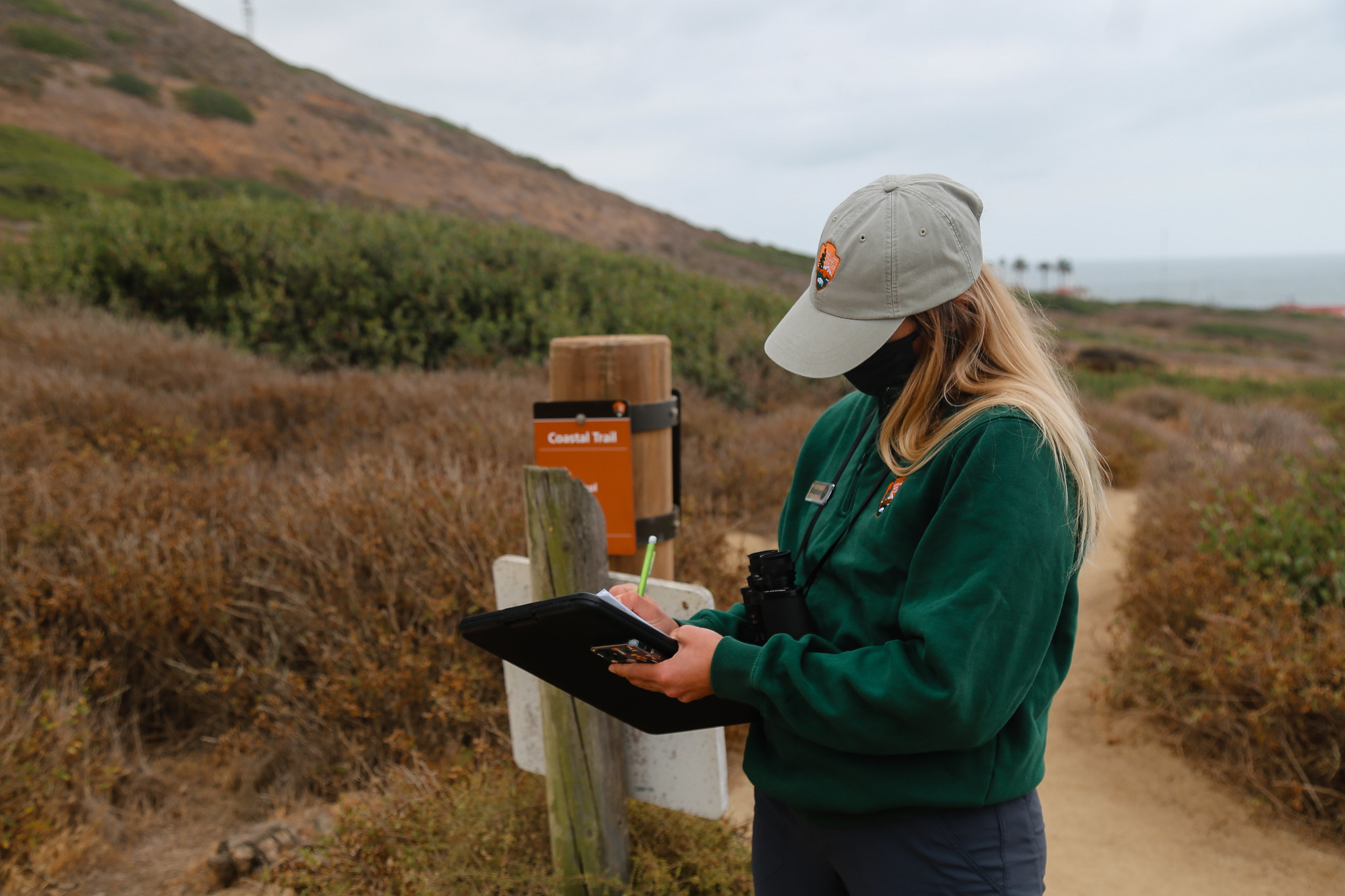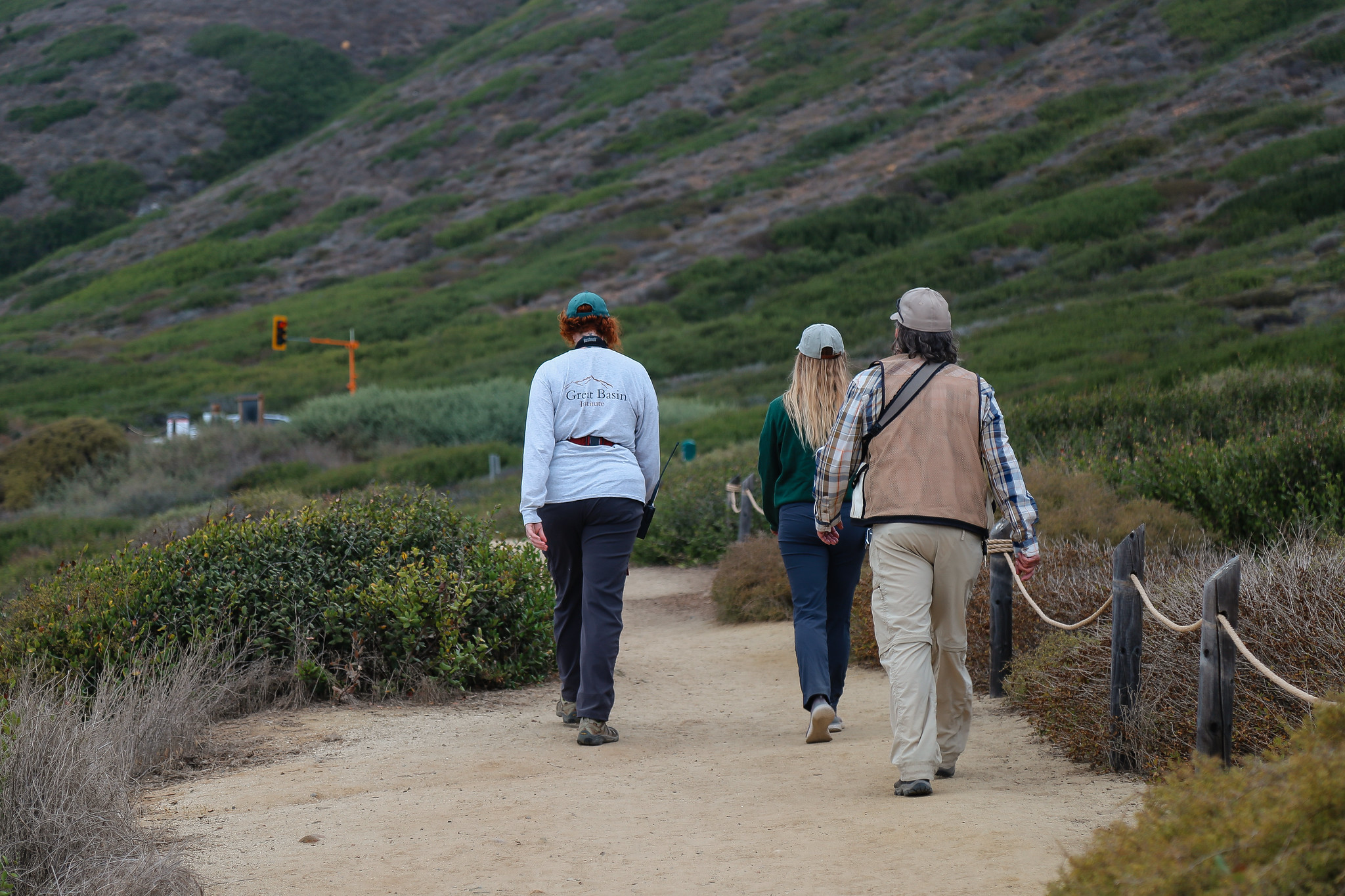As an intern at Cabrillo National Monument, I have had a unique opportunity to experience many different parts of what life looks like while working for the National Park Service (NPS). When beginning the position, I was taken on as an interdisciplinary and communications intern. This entailed that I work with the Interpretation and Education Division to tell a story about the resources and history surrounding the Coastal Trail hike. By the end of this process, I partook in extensive fieldwork, assisted rangers with managing the Visitor Center, worked with the Resources Department for park restoration, and designed a guided tour for the NPS mobile app!
The beginning of my internship was filled with meeting lots of employees that were excited to share their knowledge with me. Many of my first shifts involved learning the park, the opening and closing procedures, and the goal of my project. As an intern, the main goal of my time was to complete a capstone project to present at the end of my session. For this project, I worked to create an audio-based tour for the new National Park Service mobile app! This tour encompassed the Coastal Trail at the park. While writing the tour, I focused on the history of the area's land usage and the area's natural resources, such as the Gray Whale migration, tidepools, kelp forest, geology, Chaparral plant community, bird identification, and military history. The second project I was able to participate in during my internship was conducting fieldwork. Approximately once a week through the end of May, I worked with a mentor to conduct bird surveying for the parl. During these surveys, we counted shorebird and sea birds within the park. Shorebird data collection occurred during low tide conditions to allow for access to all areas of the intertidal zones. In order to be counted in the shorebird survey, the bird had to land in the Rocky Intertidal Zone. For both, we collected data on each bird including species name abbreviation, sex and age if traits can be determined, and any interesting behavioral observations. Additionally, we recorded whether the bird was identified by visual, call, song, or flyover. As a result, I became familiar with many of the local birds by visual ID and when possible, by vocalization. The vocalization that I became the most comfortable with is the Wrentit (Chameae fasciata) because their song sounds like a ball bouncing! When a female sings it sounds like a ball bouncing steadily and the male sounds like a ball bouncing away (meaning the song begins steady and then speeds up after approximately four beats).

NPS Photo/ C. Aurrecoechea - Intern Madison O’Barr collecting data during terrestrial bird survey.

NPS Photo/ C. Aurrecoechea - Biologist Sam Wynns, volunteer Bob Sharp, and intern Madison O’Barr hiking the coastal trail to reach surveying site.
Towards the end of my time at the park, I was able to shift my fieldwork time from conducting bird surveys to working with the vegetation team. For my first shift, I worked at the NPS greenhouse to help with restoration projects. At the beginning of each shift, employees start by watering all of the sprouts and plants being grown and check for dead individuals. An important part of this process is keeping an eye open for pollinators. If pollinators are spotted, they are photographed and recorded. I was then able to help with transplanting native plants into larger containers to encourage growth. Because the park is located within a Mediterranean climate, it is important to only introduce plants that are large enough to survive the drought conditions. Herbivory is also another common reason that plants may not survive if planted too young. Many specimens have been in the process of maturing for 1-2 years to ensure their success. During my second shift, I was able to work on non-native plant removal near the Coastal Trail. Due to the utilization of the area by many different government organizations, there was previously a large number of non-natives introduced to the landscape. As a result, a plant restoration team works closely to remove these plants when they die off seasonally.
The final duty I held during my weekend shifts was to assist guests at the Visitor Center. A primary goal of my internship was to better understand how the public interacts with national parks. My goal was to use the interactions I had with guests to better understand what they would want in a tour. Some of the requests I heard were that there was information about the local wildlife which helped to inspire my tour stop about birding! Many of these shifts included interfacing with children who wanted to partake in the Junior Ranger program, providing directions, explaining park history, and helping visitors better understand the city. From my time working at the Visitor Center, I was reminded that people who visit our national parks do so with the desire to enjoy what nature has to offer. After taking many classes focused on the damage humans cause, both consciously and unconsciously, I had formed an assumption that land management primarily entailed policing visitors. Being able to interact with the public reminded me of the humanity we share and our common desire to enjoy nature. Additionally, spending my weekends with the park rangers allowed me to get a glimpse into how much effort the employees give to providing visitors with a pleasant experience. As much as the rangers work to preserve the natural resources, they also take on the task of ensuring each guest forms a bond with the park. One way of providing this experience for guests is by ensuring that there is a safe space for visitors to learn, both hands on and through conversation, and appreciate the park to encourage future stewardship.
With the skills I have developed in this position, I feel significantly more knowledgeable about what working in a federal position would entail. Although I had previously volunteered at this location, I did not truly understand what it meant to work with the National Park Service. Although it was a short internship, the experience gave me an inside view to realistic timelines, how the chain of command functions, the close involvement of the staff with visitors, and approaches to resource management.
|
October 12, 2021
|
Last updated: October 20, 2021
